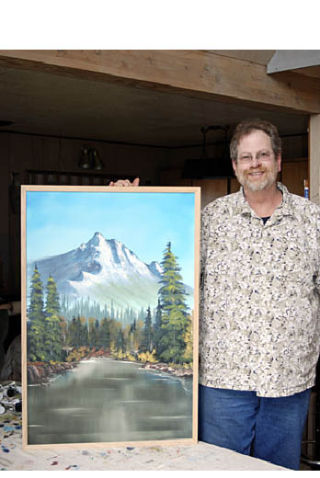Tucked away on the west facing point of Neck Point Coves, with a waterline view of Yellow and San Juan Island, lies the home and studio of oil painter Eric Boyles. A nine-year resident of the San Juans, he is known to many on Shaw Island as their local gardener and landscape artist. But to those of you who have happened upon his work at the Lopez or Orcas Island Farmers markets, he is known for his three dimensional landscapes, inspired by the style and technique of the late Bob Ross.
Upon entering his living room and studio you are greeted by a wall of vibrant landscapes ranging from tropical seascapes to wilderness moonscapes in the dark of night. One might think that his gallery of work is the result of years of study and practice, but in truth, his display is but a sampling of the work that he has produced in just three years of painting.
It was on a trip to Hawaii in 2006 to visit his two sisters, Lisa and Bethleen, that he was introduced to the art of painting. During the visit, “Bethleen broke out her paints and asked me if I wanted to join her. I had never picked up a paintbrush in my life. We started with simple landscapes. My sister noticed my work and suggested I pursue more art.” After his initial inspiration from his sister, he drew from his interest in the work of Bob Ross, who was commonly known for his painting instruction shows on public television. Boyle recognized that “the goal of Bob Ross was to open the world of art to people who would other wise never be able to enjoy the fun and art of painting. I was inspired by the way Bob Ross was so calming. He let his audiences know that they could do it too.”
Boyle started working with acrylic paint but found it less forgiving than oil. Similar to watercolor painting, you have to be more exact. He pointed out, “There is no room for mistakes. But with oil, you can just scrape it off if you don’t like something, and just start over.” In particular Boyle was inspired by Bob Ross’ technique of “wet on wet painting, which is the basic process of painting over layers of wet paint to achieve relatively fast and effective results.”
When asked what keeps him at the easel “creating two to three paintings at a time sometimes,” love is the first word from his mouth. “When I am painting, I feel so in tune with the way a tree grows, for example. It took me several months to learn how to paint a tree branch so it looks realistic to the eye. I literally walked around in the forest for days so I could get the right perspective. You have to be in love with the canvas, in love with what you are doing. And what has come from my painting is a deeper love of nature, and a deeper regard for fellow man.” One of Boyle’s greater joys is evaluating the painting he has just finished whether he is satisfied with it or not. “There is always something new to learn or improve on,” he says. “These evaluations excite me and get me instantly motivated to start another painting immediately.”
It is that love and regard for humanity that so many artists agree is at the core of their work. And to see it so abundantly displayed on the walls of Eric Boyles’ studio is a testament to the creed of creation. “Painting has made me look at my surroundings more closely. I have developed such a love for the outdoors, for where I live, and I feel so blessed to be able to paint it. Most of the time while driving here or on other islands, I’m surrounded by more ideas of what to paint and I sometimes become distracted by the observation of being able to paint this cloud with a fan brush, a mountainside with a one inch brush or how I can achieve the spectacular sunset that I’m watching out of my windshield, to the point of almost driving off the side of the road.”
And in his final summary of the joy, challenge and growth that comes from his art, he adds, “I hear a lot of people say that they have no talent, but talent is nothing more than pursued interest. Each painting is a learning experience for me. There are no mistakes or failures… only learning. It is the dissatisfaction of one piece that creates the motivation necessary to start the next painting.” His thoughts on selling his work are likewise humble. “It is not about the money to me, it is about the effect the painting has on my heart.”



